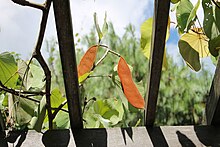Phanera vahlii
| Phanera vahlii | |
|---|---|

| |
| Flower in Ananthagiri Hills, in Ranga Reddy district of Andhra Pradesh, India | |
| Scientific classification | |
| Kingdom: | |
| (unranked): | Angiosperms
|
| (unranked): | |
| (unranked): | |
| Order: | |
| Family: | |
| Subfamily: | |
| Tribe: | |
| Genus: | |
| Species: | P. vahlii
|
| Binomial name | |
| Phanera vahlii[4] | |
| Synonyms | |
| |

Phanera vahlii is a perennial creeper of the family Caesalpiniaceae native to the Indian subcontinent.
The roasted seeds of this woody climber are edible.[5]
Phanera species have 2–3 fertile stamens.[6]
Distribution[]
Phanera vahlii is found from Sikkim and Nepal across India and Punjab, Pakistan.
Local names[]
In Hindi, it is called मालू malu, but also mahul, jallaur and jallur. In Nepali it is called भोर्ला bhorla. In Odia, it is called ; ସିଆଳି Siali, இலை மந்தாரை in Tamil. In Telugu, it is called అడ్డాకు.
References[]
- ^ The Legume Phylogeny Working Group (LPWG). (2017). "A new subfamily classification of the Leguminosae based on a taxonomically comprehensive phylogeny". Taxon. 66 (1): 44–77. doi:10.12705/661.3.
- ^ Sinou C, Forest F, Lewis GP, Bruneau A (2009). "The genus Bauhinia s.l. (Leguminosae): A phylogeny based on the plastid trnL–trnF region". Botany. 87 (10): 947–960. doi:10.1139/B09-065.
- ^ Wunderlin RP (2010). "Reorganization of the Cercideae (Fabaceae: Caesalpinioideae)" (PDF). . 48: 1–5.
- ^ Sinou, C.; Forest, F.; Lewis, G. P.; Bruneau, A. (2009). "The genus Bauhinia s.l. (Leguminosae): a phylogeny based on the plastid trnL–trnF region". Botany. 87 (10): 947–960. doi:10.1139/B09-065.
- ^ Khan, M., & Hussain, S. (2014). Diversity of Wild Edible Plants and Flowering Phenology of District Poonch (J&K) in the Northwest Himalyay. Indian Journal Sci. Res 9(1): 32–38.
- ^ Wunderlin, R. P. (2010). "Reorganization of the Cercideae (Fabaceae: Caesalpinioideae)" (PDF). Phytoneuron. 48: 1–5.
External links[]
| Wikimedia Commons has media related to Phanera vahlii. |
Categories:
- Cercidoideae
- Flora of Nepal
- Fabaceae tree stubs